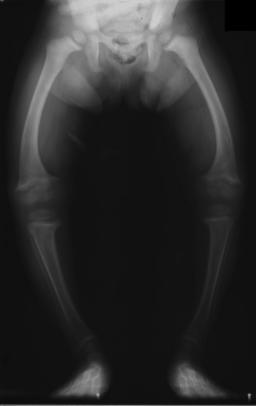The childhood ailment rickets--in which vitamin D and calcium deficiency leads to soft bones and poor growth--is making a surprising comeback, according to the American Academy of Pediatrics. Virtually eradicated by the 1960s, rickets seems to be on the rise because toddlers are not consuming adequate amounts of milk--the primary dietary source of calcium and vitamin D.
"In our [study], we found cases of young children who are suffering from undernutrition simply because their parents fed them soy- or rice-based beverages that did not contain vitamin D, instead of cow's milk," indicates Norman F. Carvalho, a pediatrician at Children's Healthcare of Atlanta. "Rickets and other nutritional illnesses can be serious and may lead to potentially life-threatening complications."
In addition to soy- and rice-based beverages, pediatricians are concerned that children may be drinking excessive amounts of soft drinks, juice, and juice drinks in place of milk. These beverages don't contain the nutritional profile of cow's milk, yet they increasingly are being substituted for it. Even calcium-fortified juices and juice drinks don't contain vitamin D. "Soy and rice beverages may look like cow's milk, but these products may not contain the amount of calcium and vitamin D that's needed for proper growth and development," Carvalho maintains.
Rickets can result in stunted growth, delays in motor development, and bow legs in children. This nutritional disease was essentially eliminated in the U.S. decades ago following the fortification of milk with vitamin D.
According to Susan Baker, professor of pediatrics, Children's Hospital of Buffalo (N.Y.), it is typically "nutritional ignorance" in this country, rather than food deprivation, that leads to nutritional deficiency-caused ailments such as rickets. Because it was previously rare, many U.S. physicians may be unfamiliar with the clinical features of specific nutritional deficiencies. Today, there is a renewed urgency for pediatricians to monitor for rickets. The American Academy of Pediatrics has long suggested overall evaluation of a child's diet along with detailed counseling and parental education with a registered dietitian when necessary.
"With increasing numbers of parents exploring strict vegetarian diets, many may be making inappropriate changes to their children's diets," Carvalho cautions. "Additionally, some parents may mistakenly believe their child is allergic to milk or lactose intolerant, and needlessly switch to alternative products. If we are to avoid relearning the lessons of the past, we should ensure that children consume adequate amounts of calcium and vitamin D each day. Milk is the only dairy product that is routinely fortified with vitamin D, and it's one of the few dietary sources of this essential nutrient." (The other major source is ultraviolet light from the sun, but with concerns about skin cancer protection, pediatricians warn against excessive sun exposure for children.)
In addition, parents should realize that rice beverages are not an appropriate milk alternative for toddlers because the protein content is inadequate. If soy beverages are used, they should be fortified with vitamin D and calcium if they are to be a major part of a toddler's diet. Not all soy beverages are fortified with calcium, and the calcium content varies dramatically by brand. Additionally, the calcium in soy beverages is not absorbed as well as that in cow's milk, research indicates.
COPYRIGHT 2001 Society for the Advancement of Education
COPYRIGHT 2001 Gale Group



